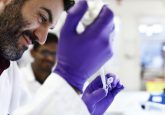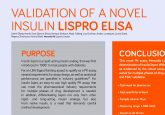Hanna Ritzén on classification of commercial LBA kits for biomarkers

To help provide insight into the recent article published in Bioanalysis: Recommendations for classification of commercial LBA kits for biomarkers in drug development from the GCC for bioanalysis, we spoke with author Hanna Ritzén, Managing Director for Research and Development at Mercodia (Uppsala, Sweden). Hanna explains why she felt this was an important area for bioanalysis and worthy of publication.
“My name is Hanna Ritzén and I am currently the Managing Director for Research and Development at Mercodia AB, a Swedish biotech company that specializes in the development and production of ELISA assays as well as bioanalytical services, within the area of metabolic disorders. I started my career at Mercodia as Product Development Specialist back in 2002, and since then I have held different positions in our Research and Development department. I have been involved in the CAPA process and life cycle management of the internally developed and produced ELISA kits, that are used to detect biomarkers in both human and animal samples.
Today, I am responsible for the product development of commercial IVD and RUO ELISA kits and post market surveillance, as well as the assay development and validation and sample analysis in our bioanalytical services. I am also involved in the clinical laboratory test standardization and harmonization of insulin and C-peptide biomarker methods administered by the American Association of Clinical Chemistry. This due to my long experience with product development at Mercodia and my high interest in measurement quality.”
1. What inspired you to work with the classification of LBAs?
There are a variety of different assays on the market. To me it is very important with quality, transparency and efficiency; how we can engage the stakeholders in the bioanalytical community and also learn from biomarker measurement in clinical diagnosis.
2. What impact would you like to see/expect to see as a result of your publication?
Context of use and user needs is always important when starting a new project with the sponsor and specifically for biomarker assays. The publication gives food for thought regarding the quality.
The clinical utility of biomarkers involves discovery and validation for an intended use. Making the right interpretation of data rely on the expertise of the scientist and the quality of the measurement methods.
3. What are the next steps for your research and this field of bioanalysis?
To continue work with best practice of developing and validating biomarkers in the bioanalysis arena. There are several regulatory guidelines from the EMA, FDA and soon ICH M10 will come out, and supersede the previous, for pharmacokinetic but not for biomarker assays.
We also want to learn and evolve from the clinical diagnostic arena where great effort is given to improve the quality of biomarker measurements, and the analytical error of a method is evaluated and compared with the medically allowable error. This has been done by, for example, standardization, harmonization and guidelines on how to perform and report validation results as well as establishing acceptance criteria of analytical results. The European Federation of Clinical Chemistry and Laboratory Medicine has published a consensus statement on three models to set analytical performance specifications for biomarkers; based on clinical outcomes, biological variation and state-of-the art.
Both in the bioanalytical arena of drug development and the clinical diagnostic arena, the stakeholders (i.e. sponsors, clinicians, laboratories, manufacturers and regulatory bodies) often lack an in-depth understanding of the needs of other stakeholders. To improve patient outcomes, advancing the collaboration between stakeholders is desirable. This is something I would like to be involved in further and believe Mercodia is a good partner for this due to many years of experience in both fields.
4. Do you have any advice for anyone who may be interested in working with validation of LBAs?
If you develop the assay yourself, you should spend a lot of time to get to know your reagents, since well-established and characterized reagents are key to achieve an assay that is robust, specific and sensitive. Stay curious and interested in the theory and results.
When choosing a commercial assay ask a lot of questions, it might not always be as it looks at a glance and set priory criteria based on your context of use. Will you be using several lots for example; the following considerations must be taken into account: assay imprecision, appropriate samples, allowable bias for the analyte, biological variability and clinical utility.
Reference: Islam R, Kar S, Ritzén H et al. Recommendations for classification of commercial LBA kits for biomarkers in drug development from the GCC for bioanalysis. Bioanalysis. 11(7): 645–653 (2019)




